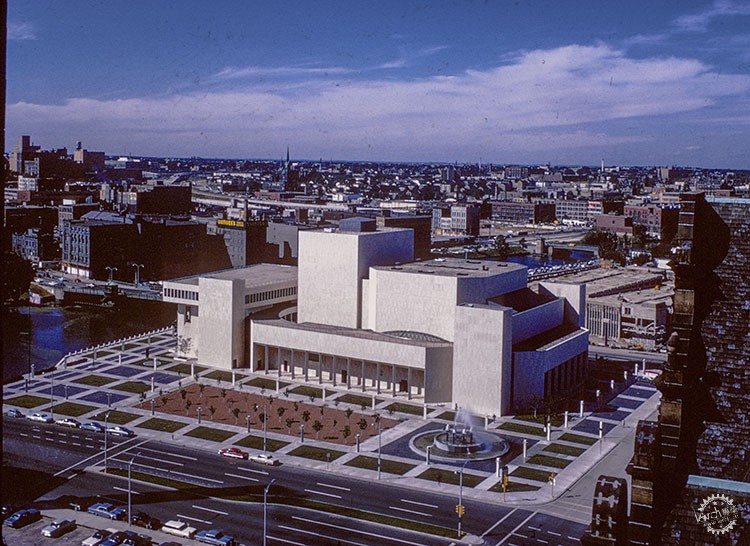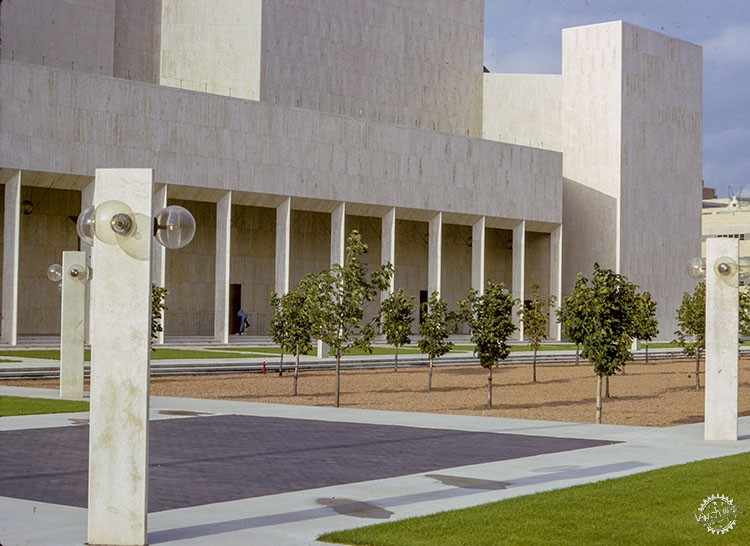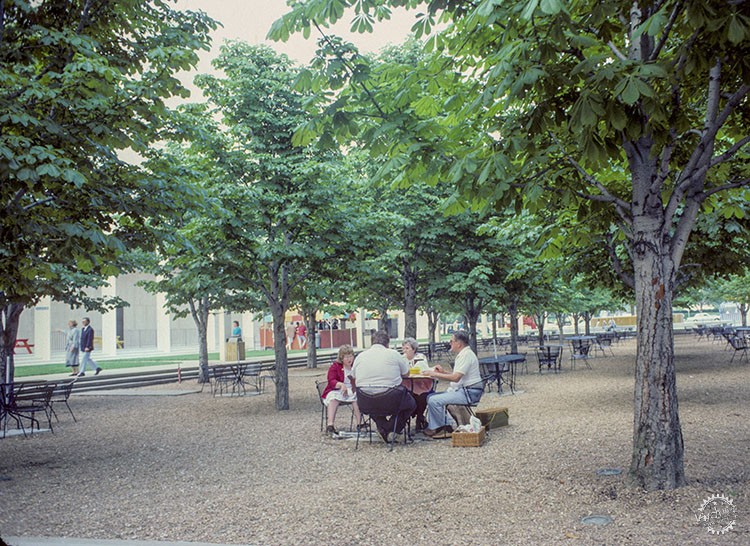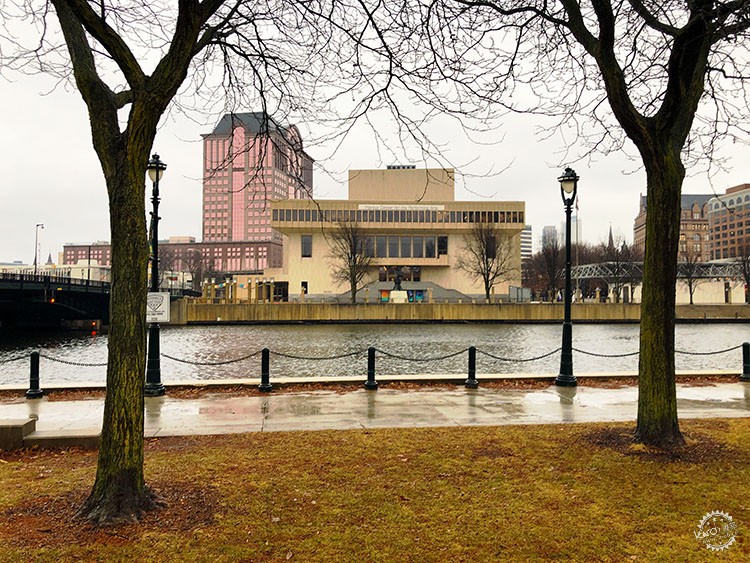
GREAT LAWN VS. GROVE
由专筑网胡婧宜,李韧编译
Dan Kiley在第二次世界大战后逐渐形成了一套独特的设计方法。在为Nuremberg纳粹战犯的审判设计审判室后,他研究了诸如凡尔赛宫等古老的欧洲花园,并将它们的廊道、丛林和灌木丛通过现代的景观设计手法来表达。如Kiley所说,这是“引导传统手法创造出‘具有结构完整性的空间’”,或如FASLA的Joe Karr的评论所述,Dan Kiley经常以建筑手法利用植物,以植物体块形成空间结构。
Kiley的美国密尔沃基Marcus表演艺术中心景观区域就位于密尔沃基河市中心旁边,是一处植物组织的设计典范,也是一处有幸得以保存的景观区。文化景观基金会的负责人与CEO Charles Birnbaum认为:“这座景观设施更加真实,有着其他至今得以保留的景观大作的特征。”但Marcus中心现在计划在地块上拆除Kiley所设计的主要景观特征,即36棵七叶树的树阵,而以大草坪代之,用于大型公众集会。这与Kiley的设计意图完全相反。
Dan Kiley developed his approach to landscape design in the wake of World War II. After designing the courtrooms for the trials of Nazi war criminals at Nuremberg, he explored the classical European gardens such as the Tuileries, Villandry, and Versailles, and translated their allées, bosques, and hedgerows into modern expressions of landscape design. Channeling this tradition created “spaces with structural integrity,” Kiley wrote.
“The trees form a mass that’s almost a structure,” says Joe Karr, FASLA, who worked with Kiley from 1963 till 1969. “Dan quite often used plants like an architect would use other materials.”
Kiley’s landscape for Milwaukee’s Marcus Center for the Performing Arts, which sits next to the Milwaukee River downtown, exemplifies these lessons. The Cultural Landscape Foundation’s President and CEO Charles Birnbaum, FASLA, says it’s “truer to the Tuileries as any Kiley landscape that survives today.”
But the Marcus Center is now planning to destroy Kiley’s primary landscape feature on the site: a grid of 36 horse chestnut trees. A new plan will replace the trees with a great lawn for large public gatherings, quite contrary to Kiley’s design intent. Construction is tentatively slated to start in the spring.

1970年的Marcus中心树阵/The Marcus Center grove in 1970. Photo courtesy Joe Karr, FASLA, and the Cultural Landscape Foundation.
新设计师James Shields曾在巴黎居住,并数十次访问杜乐丽花园。他表示一直很敬佩Kiley对树阵的运用,但同时树阵的不灵活性影响了它适应时代的发展,比如它无法适应残疾人法案的规定,这使得改进很有必要。
Marcus中心已有50年历史。Kiley的原有景观设计区旁侧是一座音乐厅,这座音乐厅由建筑师Harry Weese设计。Weese的野兽派建筑非常朴素,以模糊的古典体量为中心,并且不对称地下沉。除了Kiley所应用的紧密的树阵之外,另一个草地和人行道的网格图案围绕线性森林分布,形成设计秩序,沿着建筑物向外辐射。 这一手法模糊了景观与建筑之间的界限,这也是它成功的一个原因。
The architect behind the new plan, HGA’s James Shields, has lived in Paris, visiting the Tuileries dozens of times, and says he’s “long admired the Kiley grove.” But he also says degradation of the plantings over time, Americans with Disabilities Act compliance, and, most important, programmatic inflexibility make it infeasible to save.
The Marcus Center turns 50 years old this year. Kiley’s original landscape accompanies a concert hall by the architect Harry Weese, his frequent collaborator. Weese’s Brutalist building is austere with a vaguely classical massing—highest at its center, and stepping down asymmetrically. Beyond Kiley’s tight grid of trees (sunken below grade a few steps), another grid pattern of grass and pavements orbits the rectilinear forest, making the landscape more and more ordered as it radiates outward from the building. The project has “very blurred lines between the work of the architect and the work of the landscape architect,” Birnbaum says. “That’s what makes it so successful.” This continuity can be traced to Kiley and Weese’s close relationship, and also to Karr, who worked in Kiley’s office for much of the project, and then moved to Chicago to open his own firm—which often provided landscape design for Weese—as the Marcus Center neared completion.

1986年的Kiley树阵/The Kiley grove in 1986. Photo by Joe Karr, FASLA, courtesy of the Cultural Landscape Foundation.
新景观的设计也将伴随着对Weese原有建筑的修整,新设计方案增加了窗户,减少现有的深色玻璃,使其远离中世纪审美,成为一座更加开放市政中心。“从外面看起来它就像一座堡垒。”Marcus中心总裁Paul Mathews说。他希望通过改造可以让场地更加面向外部,吸引更多观众。这是“文化相互融合、学习的机会。”
改造方案增加了一系列窗户,这些窗户从酒吧和休息区朝向Kiley设计的树阵,Shields认为,这些树阵会构成景观视角的阻挡,它们由于长期缺乏合理维护,原先设计的光影关系逐渐丧失,变成了一片难以穿透的厚重阴影。Shields与Karr都认为,Kiley并没有过多地考虑景观的可持续性,但这也是常见的问题。Shields说:“虽然曾经的夏天,我们都在这里感受过斑驳的光影,但是现在确实一片昏暗。这就如同无法逾越的森林。”他建议,四棵树受到了严重破坏,必须立即移除,用于铺设树林的砾石不符合残疾人通行标准。即使Marcus中心负责人希望保留这片树阵,但它们也面临着重新种植的需求。另外,树阵下部有几级台阶,残疾人无法通行,在这样的情况下,Shields认为这并不是特别困难的事,Karr认为,如果不完全拆除树阵,也能够通过设计的策略进行后期调整,他说:“我认为这很容易做到。”如果通过最小的干预手段进行改造,完全可以利用树阵和建筑之间的空间,从树阵向下修建一条轮椅可通行的坡道,并拆除一个不再启用的大型喷泉。
The new landscape will also accompany revisions to Weese’s building that move it away from its severe midcentury modern aesthetic, and make it a more public-focused civic center. This entails more windows cut into its blank facade and less dark glass. “From the outside of this place, if you don’t know it, it can look like a fortress,” says Paul Mathews, the Marcus Center’s president and CEO. The renovations are a chance for the venue to become more outwardly focused and attract new diverse audiences, he says. It is “a chance for cultures to intermingle with each other and learn from each other.”
These renovations will add a new band of windows that look out to the grove from a bar and lounge area, and Shields says the thick grove will block these views. The trees, he says, haven’t been maintained in a way that preserves the patterns of light and shadow below that Kiley intended. Shields and Karr both say that Kiley did not give landscape maintenance instructions to the Marcus Center, but the lack of instructions was not out of the ordinary. “While we used to get dappled light in there during the summer, it’s a giant dark mass now,” says Shields. “It’s an impenetrable forest.” Four trees, he says, are so damaged they need to be removed immediately, and the gravel used to pave the grove is not ADA accessible. Even if the Marcus Center had decided to preserve the grove, they’re nearing the need for a complete replanting, Shields says. Additionally, the grove is down several steps, and has no ADA-accessible ramp, which the new plan will fix. In isolation, Shields conceded that ADA accessibility wasn’t an “overwhelmingly difficult issue.” And Karr says it’s quite possible to fix the inaccessibility without removing Kiley’s grove. “I think it could be done very easily,” he says. The space between the grove and the building seems large enough to accommodate a ramp, as does the east end of the grove, where a large fountain that’s no longer functional is to be removed.

今天的Marcus中心/The Marcus Center today. Photo by Zach Mortice.
但最终落实的改造计划完全利用草坪取代了树阵,仅在两侧各保留一排九棵树,作为对原始设计的温和回应。新设计的重点将是一个多层楼梯塔墙,它将成为播放免费公共节目的多媒体屏幕。
用多种体验形式吸引游客成为了现在设计的一种流行趋势,例如华盛顿的国家博物馆每年一度设立的夏季街区,及其中庭的沉浸式体验。显然设计师试图在Marcus中心借鉴这种设计方法,但有批评声音认为,这只是一种纯粹为吸引游客所作的简单搬运,并没有建立在任何场所理解的基础上。
The lawn that will supplant Kiley’s horse chestnuts will have a row of nine trees on either side, a mild echo of Kiley’s original arrangement. (Shields says that landscape architects with the engineering firm GRAEF are working on the project.) The focus of the new design will be a multistory stair tower wall, which will become a media screen for installations that Mathews hopes will enable the organization to offer more free public programming.
The urge for cultural organizations to increase visitor numbers with crossover programming is a common trend, perhaps best exemplified by the National Building Museum’s annual Summer Block Party installations in Washington, D.C. The immersive experiences in the museum’s cavernous atrium have become a huge draw. But at the Marcus Center, Birnbaum says, “It’s a generic approach. It’s a program-driven, tabula rasa approach that does not put a value or a depth of understanding on what is there now.”

今天的Kiley Grove/The Kiley Grove today. Photo by Zach Mortice.
景观改造也在消耗大量的公共资金。Marcus中心预计,在未来几年内,密尔沃基县每年已经逐渐减少的拨款,由于养老金的增加以及其他费用的压力而消耗殆尽。目前的资助协议将使公共捐款每年减少50,000美元。此外,场地的一个主要租户密尔沃基交响乐团明年将搬去新场地,并带走一系列节目和资金。这些预期的紧缩措施促使艺术中心更加趋向“完成任务”并且“精益求精”。中心管理者认为,保持“毫无用处”的景观将成为他们无法承受的奢侈品。
改造计划负责人Shields承认,他们的主要设计目的在于帮助Marcus中心赚钱,通过聚集更多的人气,获取更多的捐助。因此对艺术节目没有任何帮助的Kiley树阵就被牺牲了。
“我知道肯定有很多专业人士反对,但是权衡利弊,我们还是会这么做。”
Shields相信,Marcus中心的社会使命在于改善城市的种族隔离现状,所以设计师们更倾向于关注社会和文化目标,而不是为了保留而保留。
Also driving the landscape change is retracting public sector funding. The Marcus Center expects to see its already fading annual appropriations from Milwaukee County drop to zero in just the next few years, under strain from swelling pension commitments, among other expenses. The current funding agreement will see public contributions drop by $50,000 each year. Additionally, a major tenant, the Milwaukee Symphony Orchestra, will settle into a new venue next year, taking with it a block of programming and funding. These anticipated rounds of belt-tightening have prompted the arts center to be more “mission-driven” and “as lean as they can,” Shields says. Maintaining the Kiley landscape that is “of no use to you,” Shields says, would become an extravagance they can no longer afford.
And if HGA’s slate of interior renovations is aimed at making more money, their landscape changes are focused on first gathering a broader audience and their wallets, at the expense of the Kiley grove, which has not played a large role in directly accommodating artistic programming. It’s a sacrifice Shields is willing to make.
“I think there are definitely some professionals in my role that would resign over a thing like this one,” he says. “I weighed that, but decided that it was something I wouldn’t do.”
Shields believes in the Marcus Center’s social mission, especially considering Milwaukee’s infamy as the nation’s most racially segregated city. “Frankly, I have more attachment to what the Marcus Center has been able to achieve as a social and cultural institution,” he says. “I’m more attached to that, and I value it more than I do that preservation of the Kiley [landscape.]”

Milwaukee 河沿岸的Pere Marquette公园/Pere Marquette Park, just across the Milwaukee River from the Marcus Center. Photo by Zach Mortice.
但同时有反对声音认为,就像在市中心建立河滨开放空间一样,要寻求融合城市的方法有多种,或许保留Kiley树阵与此并无矛盾。
比如与Marcus中心隔河相望的Pere Marquette公园,这两座公园由两座人行天桥相连。公园有一片宽阔的绿地,比Kiley树阵大几倍。为什么不把Pere Marquette 公园和Kiley景观的场地作为以艺术为中心的大草坪聚会空间?“我不认为这是可行的。”设计者之一Mathews说,“它们是不同的空间。Pere Marquette公园几乎都是开放场所,并不适合作为艺术集会区,而且它们应该保持自己的特色。”
即使备受压力,以Shields为首的设计师们不得不继续工作,但对设计的争议要求他们考虑项目未来的改造灵活性。新树丛根部没有做任何基础,使其更容易移植,设计师预计,如果将它们改造回原先的树阵形式只需要一周,且仅需花费75万美元。这可能是对“是否保护Kiley树阵”争议的最大程度妥协。
Marcus Center administrators are right to look for ways to bring their city together, just as they’re right to focus on establishing more riverside civic–front yard space in the city’s downtown. But maybe accomplishing both of these things while preserving the Kiley grove doesn’t require looking very far away at all.
Pere Marquette Park is located just across the Milwaukee River from the Marcus Center, and is connected to it by two pedestrian and vehicular bridges. It’s owned by Milwaukee County, which currently leases the Marcus Center site to the arts venue. It’s a broad green, several times larger than the Kiley grove. Why not use Pere Marquette Park as an art-centric great lawn gathering space (especially since they share the same landlord), and spare Kiley’s landscape? “I don’t think it’s feasible,” Mathews says. “They’re different kinds of spaces. It’s pretty much open space out there, and they’re going to keep it that way.”
Shields’s professional ethics allowed him to stay on the job, but it also required him to plan for future flexibility. Digging up the grove is “not an irrevocable move,” he says. He intentionally placed no infrastructure below the grove’s footprint so that it can relatively easily be replanted. But this flexibility seems to be an implicit argument for the grove’s preservation: Shields says it could be replanted in a week for only about $750,000.

Pere Marquette公园方向的Marcus中心/The Marcus Center today, as seen from Pere Marquette Park. Photo by Zach Mortice.
|
|
